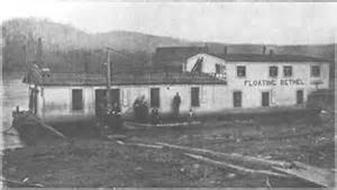

|
Church of God Reformation Heritage
These are some of the questions and conditions faced by George T. and Lizzie Clayton. It had already been a long journey. George came up with the idea of taking a barge and converting it into a church and living quarters in 1893. The unpowered barge was impressive and its name even more so as it was christened the Floating Bethel. Most impressive though was the message burning in their hearts and the love they had for those living along the rivers.
Things went fairly smoothly as they left port in Pittsburg, Pennsylvania in 1894. The plan was to float down the Ohio River to Cairo, Illinois, where they would then ride the currents of the Mississippi clear down to New Orleans and the Gulf of Mexico. The work was exhilarating as they evangelized both sides of the river at every town they could make a landing, but things soon changed.
In January 1895 the rains fell, the snows melted, and the Ohio River began to overflow. The flood stage was around 25 feet, but the river soon reached 36 feet. Itís an eerie feeling to look out and see the river out of its banks swallowing up farms, towns, trees, animals, and even people. Itís hard to keep your bearings as to where the barge should flow. Though nothing was said, what I know about the river and the flooding that takes place, Iím sure they had to make landing and sit for a while. Where that was, I donít know, but Iím sure the impact of their being there so long had a lasting influence on the community.
In my experiences with the Mississippi, Missouri, and Illinois Rivers which all converge in the area of Alton, IL, just north of St. Louis, everyone pitches in to help each other. You weep over loss and rejoice over victories of pulling someone from the flood waters or being able to sandbag and stop the water from overtaking a home or business. Iím sure it was much the same then.
Once the flood waters receded to a safe level they would bid their new brothers and sisters farewell and start floating toward the next destination. They were blessed in 1896 to have a year of no flooding. Many towns were certainly visited by the gospel team and many lives brought into the fold.
Winter sets in with lots of snow and ice, but they are able to continue the journeys until around February 24, 1897.(2) Again the waters begin to rise. This time they recognize the signs of the floodís arrival and make a safe landing. ďHow long will we be here,Ē I can hear them ask. They had no way of knowing how high the river might get. This time it rose to 38.8 feet. It would be a long stay.
The following year in March of 1898 they once again had to make a long landing as the waters rose even higher than the year before, 44.6 feet. Though it seemed a tough and dangerous journey, and it was, it was a successful journey. New congregations were started and followed the teachings of D. S. Warner and the Church of God. Warner even joined the Claytons on sections of their journey.
Many of these congregations continue to thrive today. The work in establishing these churches produced some of the greatest leaders in the movement, including William Drew, Herbert M. Riggle, Harry Rogers, and W.W. Titley. These men have carried the Church of God message to many more, thus spreading the work far beyond the shores of the Ohio River.
Four years the Floating Bethel carried the message down the Ohio to every town on each side of the river, but though the message was carried far, the Floating Bethelís time ended in December 1898 while she was docked at Moundsville, West Virginia. Fire consumed the Floating Bethel, but not until after the fire of the message had consumed the communities where she had stopped as she carried the gospel team to deliver the gospel message.
During about the same time as the Floating Bethel was along the upper sections of the Ohio River outside Pittsburg, Pennsylvania, another vessel was leaving from another port in Parkersburg, West Virginia, in May 1895. It was a showboat purchased by L. C. and Jeannie Mast. They took the showboat and changed it into the Gospel Ark. Though they did not get the same publicity as the Floating Bethel did, the work was much the same. They too found them- selves facing the same challenges of the flood waters, but continued their mission of evangelizing the cities and towns along the banks of the Ohio River until their journey ended in 1898 in Point Pleasant, West Virginia. What an enormous impact these two floating churches had on the Church of God Reformation Movement, and what difficult times these two teams must have faced. As I think of this and I think of the floods they faced, the noises of the trees banging against these vessels as the occupants tried to sleep, I see the debris of ruined lives floating in the waters that churned and swirled around them, the questions and worries they faced as they went to people they didnít know to carry the gospel message.
I canít help but wonder, isnít it the same for us today? Are we willing to face the risks? Are we willing to ford the flood waters to carry that message to a nation whose lives have been ruined by sin? What kind of impact will we leave in the wake of the waters we must travel down? I pray we will be strong, knowing our God is with us and face the floods of our times in order to save people from the rising waters. Open the flood gates and let His message flow!
†††††††††††† 1. This article was originally submitted as a writing assignment for a class in the Church of God Bible Institute, and sent †††††††††††† to TM upon the recommendation of Professor Dale Shelton and Dean Dorothy Hall.
†††††††††††† 2. Note: Flood stage information was found at †††††††††††† http://www.ohiocountylibrary.org/wheeling-history/ohio-river-floods-wheeling-wv/3195
|

|
Minnie Riggle Remembers the Floating Bethel
In the Fall [sic] of 1893, Rev. George T. Clayton got an idea from a certain scripture in the Old TestamentóPsa. 72:8 [ďHe shall have dominion also from sea to sea, and from the river to the ends of the earth.Ē], and said God wanted him to build a house and a church on a barge at Pittsburgh, PA, and go down the Ohio and Mississippi Rivers to the Gulf of Mexica, carrying the gospel. He did not have any money to buy the barge, but talked to others as he held meetings, and prayed about it. Finally he got sufficient funds to buy one.
My husband, being the only child of his parents, decided to sell off all the livestock and farming tools and enter the full time ministry. As Brother Clayton was holding meetings in our community and staying with my folk much of the time, he approached husband about giving money to help build the chapel and living quarters on the barge. Rev. Jerry Stowe, a preacher who came out with us, and who was a carpenter, promised to do the carpenter work.
Of course, Brother Clayton had my husband promise that we would go on the trip with them. It was finished and we joined them in the Fall [sic]. . . . . We were tied up just north of the Sixth Street bridge in Pittsburgh, on the Allegheny River. The chapel was only one story and the living quarters were two stories. . . . We would all go out on the roof and sing, when we were going to have services. And did we sing in those days! A crowd would gather on the bridge and listen. When we had sung four or five of our Holy Ghost hymns, Brother Clayton would announce the services in the chapel on the boat, and invite folk to the services.
Photo and excerpt from A Bit of History in Gospel Work over the Years by Minnie Riggle |
